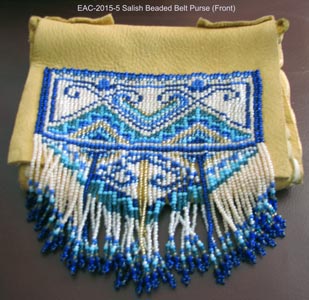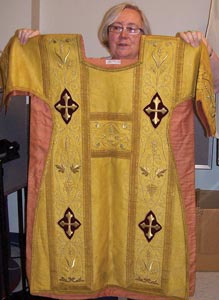
The Embroiderers’ Association of Canada/Association candienne de broderie started collecting pieces of stitchery and stitchery-related items in the 1980s, but the Heritage collection was formed in 1991 with the donation of textiles from the estate of Leonida Leatherdale, founding member of EAC. The collection really began in 1758 when some unknown child or woman stitched one of the oldest pieces in the collection — a sampler. There are purses, evening bags, embroidered panels, doilies, bits of lace, kalagas from southeast Asia, and other samples of ethnic embroideries, and the list continues to grow.
The collection is stored at Saskatchewan Government House in Regina, Saskatchewan.
Donations of stitchery have been made to the collection in recent years in memory of EAC/ACB members. Others have donated pieces they have collected and deemed worthy of a place in our history. Donations are accepted on their historical and stitching merit. Contact the Heritage Collection Appointee to inquire about the collection or to make donations.
Learn more about Samplers in the EAC/ACB Heritage Collection, the second in a series cataloguing pieces in the collection.
The EAC/ACB has developed a Sampler Registry to identify and document samplers in Canada for study and research. Learn more about the Sampler Registry project.
Borrow Items from the Heritage Collection
Chapters and museums may borrow items from the Heritage Collection. Requests should be made at least two months in advance. The Heritage Collection items are insured while they are stored and on display. Insurance must be purchased for the items during shipping. EAC/ACB will pay the shipping and insurance to the requesting organization. The requesting organization must cover the return shipping and insurance.
To request items, please complete the Heritage Loan Collection Agreement Form (fillable PDF), print when filled, have page 3 signed by an authorized person, and mail or scan and email to the Heritage Collection Appointee listed on the form.
Heritage Articles
The Heritage Collection Appointee is committed to building awareness about the variety of the collection, of which these featured items make up a very interesting part.
PDF documents open in a new page.
- Box of Bags and Purses List – Chapters and museums may borrow the collection with completion of the loan form and return postage, including $3000 insurance.
- Victorian Crazy Quilt Pincushion
- Religious Embroidery researched by Dot From
- Three-dimensional pyramid
- Wedding dress circa 1900
- Blue silk going away dress circa 1900
- Regimental cigarette silks
- Animals and flags silks
- Flag silks
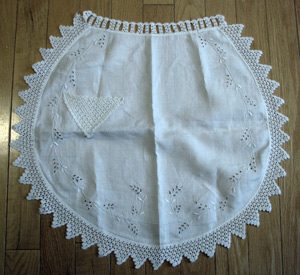
A recent addition to the Heritage Collection is this 100-year-old linen hostess apron. It is worked with eyelets and has a crocheted edge and pocket.
Maisy, the Peddler Doll
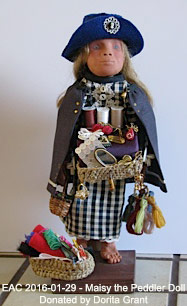
Maisy, the peddler doll, was donated by Dorita Grant of Victoria. It is one of her hand-crafted and researched character dolls. The head, hands and feet are sculptured from red clay and the body is wood. She is dressed in a costume typical of the time she would have been peddling her wares in England.
Dorita says, “The term ‘peddler’ doll refers to a collectable doll that was popular in England in the 19th century. The doll was not a toy and was kept in the parlours of ladies of means to entertain their guests. The most popular peddler doll is a figure of a woman who peddles small items. The peddlers carried their wares in their arms, in baskets, in bundles on their backs, and in any way that would allow them to carry a full load. As early as 1810, peddlers were required to have a licence to peddle confirming their good character.”
Lace-Edged Curtain Panel
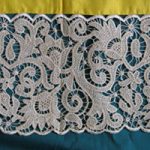
This image shows the lace edge of a curtain panel. It is almost 120 years old and was stitched by Annie Gilholm of Ontario. The curtain panel was featured in the summer 2016 issue of Embroidery Canada.
Bags and a Box from the Collection

